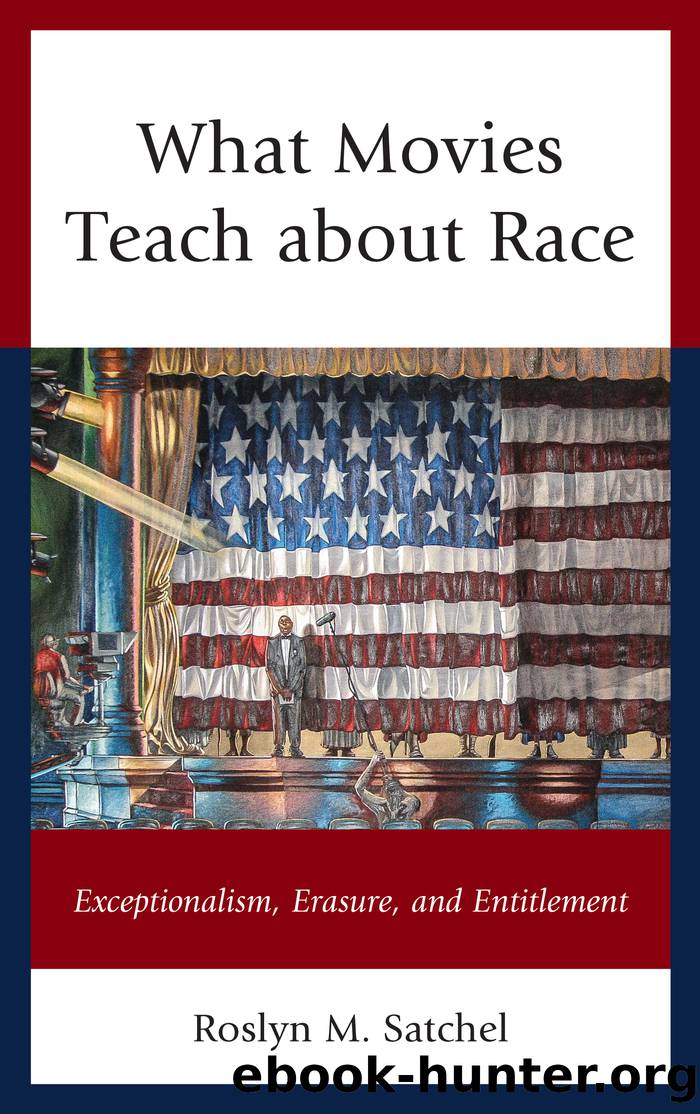What Movies Teach about Race by Satchel Roslyn M.;

Author:Satchel, Roslyn M.;
Language: eng
Format: epub
Tags: undefined
Publisher: Lexington Books/Fortress Academic
Published: 2012-08-15T00:00:00+00:00
In this sceneâs example, imperialism takes on a uniquely post-9/11 character through expressions of population control fears, the Bush doctrine of preemptive attack, and linkages between terrorism and religious and racial war. These images of white people coupled with the previously discussed words and the following actions to racially represent dominant group members with discretely stereotypical portrayals that blur the lines between what is laudatory and what is pejorative. An alternative interpretation is that these individuals are clearly evil and the movie is setting it up to show these are the antagonists, regardless of race. Further, it might mean that whites in this film are evil while the non-whites are the protagonists and espouse the better morals and values. Either way, Avatar marks a significant shift among the sampled films in its depictions of whites and Others. Whether this is an indication of historical progress, since it is the most recently released film analyzed, is an issue taken up in chapters 6 and 7.
Conversely, figure 5.6 demonstrates how sparse images of non-dominant racial group members are across the films, but when these representations do occur in Avatar they are consistently of primitive and violent combatants with tribal markings, wild hair, and scant attire that are cultish, travel collectively, and cast threatening stares from the darkness. This occurs far more than three times in Avatar (Landau & Cameron, 2009). While subordinated groups may not drum, kidnap, burn, boil, or eat anyone in Cameronâs movies, his characterizations of the blue aliens are reminiscent of turn-of-the-twentieth-century stereotypes that portrayed people of color as anonymous masses that traveled in groups, chanted, danced, entered trances, performed rites, and killed people (more on this in chapter 6).
Nevertheless, unlike the other films in the sample, Avatar (Landau & Cameron, 2009) has women of color cast not only in speaking roles, but also in leading roles. Distinctively, one Black Latina, one African American, and one white Latina are cast in leading roles. These women are uncommonly smart, defiant, and pretty warriors. Their characters are strong heroes who fight in parity with the men and children in ways that are exceptional. Several additional women of color are in the cast even though most of them are merely in the blue masses without dialogue. These depictions warrant additional scrutiny in the next chapter and in future research.
Download
This site does not store any files on its server. We only index and link to content provided by other sites. Please contact the content providers to delete copyright contents if any and email us, we'll remove relevant links or contents immediately.
Verus Israel: Study of the Relations Between Christians and Jews in the Roman Empire, AD 135-425 by Marcel Simon(555)
Infocracy by Byung-Chul Han(552)
Caesar Rules: The Emperor in the Changing Roman World (c. 50 BC â AD 565) by Olivier Hekster(534)
Europe, Strategy and Armed Forces by Sven Biscop Jo Coelmont(485)
Banned in the U.S.A. : A Reference Guide to Book Censorship in Schools and Public Libraries by Herbert N. Foerstel(453)
Give Me Liberty, Seventh Edition by Foner Eric & DuVal Kathleen & McGirr Lisa(452)
Reading Colonial Japan by Mason Michele;Lee Helen;(446)
The Roman World 44 BC-AD 180 by Martin Goodman(441)
DS001-THE MAN OF BRONZE by J.R.A(429)
american english file 1 student book 3rd edition by Unknown(427)
The Dangerous Life and Ideas of Diogenes the Cynic by Jean-Manuel Roubineau(420)
The Oxford History of World War II by Richard Overy(417)
Imperial Rome AD 193 - 284 by Ando Clifford(414)
Introducing Christian Ethics by Samuel Wells and Ben Quash with Rebekah Eklund(414)
Basic japanese A grammar and workbook by Unknown(403)
Literary Mathematics by Michael Gavin;(375)
Language Hacking Mandarin by Benny Lewis & Dr. Licheng Gu(355)
How to Reach the 9.0 in IELTS Academic Reading by IELTS Medical(337)
The Oxford History of the Renaissance by Campbell Gordon;(335)
